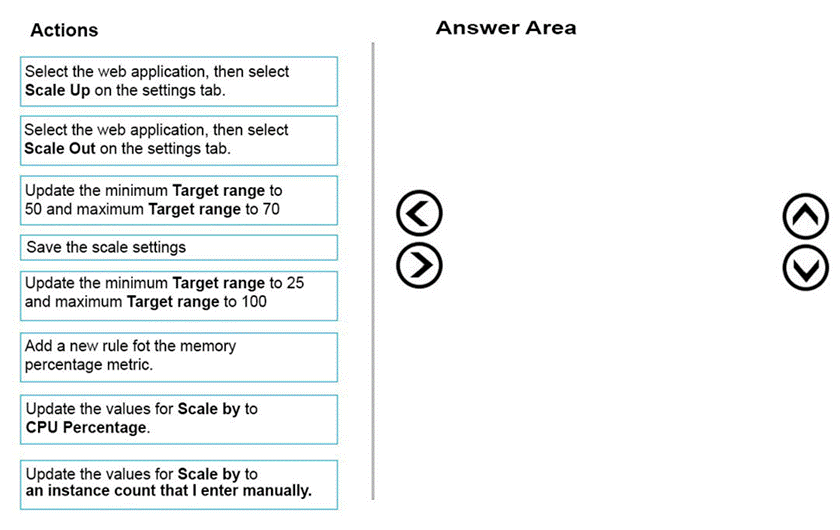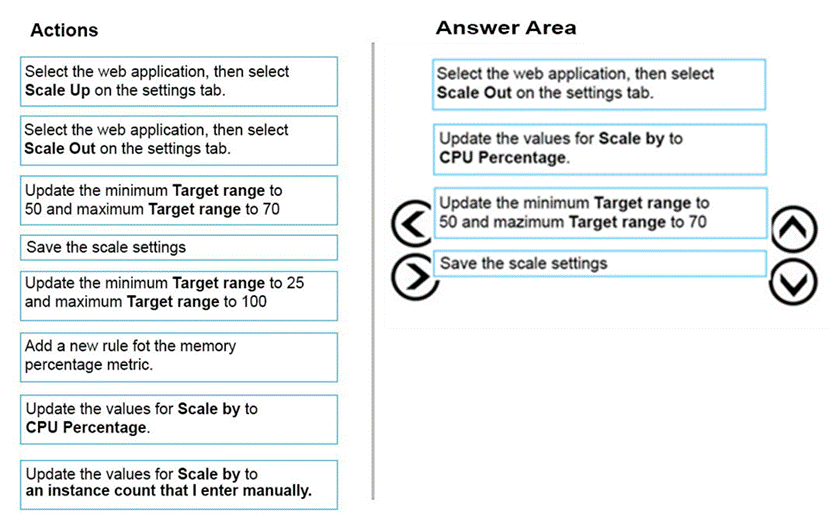In the Azure portal, which four actions should you perform in sequence?
Topic 6, Fourth Coffee
Background
You are the new cloud architect for Fourth Coffee. I he company hosts an on-premises ASP.NET MVC web application to allow online purchases and to support their retail store operations.
The new chief information officer (CIO) has announced several initiatives for the new year, including a new mobile application, online training for retail store employees, and moving the current web application and other services to the cloud.
The marketing team hopes to see an increase in the up-time for the web application. The team would also like to allow users to use social-Nogms in addition to the current username and password system.
Fourth Coffee has chosen Microsoft Azure to support their initiatives.
Current environment
In the Azure portal, you create an Azure Mobile App for the API. You create a Service Bus queue in Azure and install the Azure Storage SDK for Nodejs.
Problem statements
The mobile team attempts to use continuous deployment with the Azure App Service and the new API project. They receive the following error message: "Unable to access
‘http://fourthcoffeeapi.azurewebsites.net/’ : Failed to connect to
https://fourthcoffeeapi.scm.azurewebsites.net/ "
Business requirement
Web Application
*You must increase up-time for the application.
*The application must support additional regions and languages.
*Marketing must be able to validate the web application before updates to the application are published to the production environment.
Mobile
*The marketing team must be able to send frequent and timely updates to specific users and devices including Apple iPad. iPhone, Android. Windows, and Windows Phone devices.
*Users must be able to use their social accounts to sign in to the application. You must support Linkedln, Facebook and Google logons.
*The application must remain responsive, even during peak periods.
Training
Video streaming content must be made available and streamed to employee’s browsers. Training content must only include on-demand streaming. There will be no live content.
Technical requirement
Web Application
*You must update the deployment process to support cloud deployments.
* All data must be formatted as JSON during transport.
*You must implement Team Foundation Version Control (TFVC) as the version control system for the web application.
*Incoming messages to the API must be persisted to queue storage to ensure they are delivered and processed. You must restrict the size of messages between the mobile app and the API to no more than 5 gigabytes (GB).
*The web application must use geo-redundant replication.
Mobile
*You must use Node.js as a technology platform. You must support all mobile initiatives when possible.
*You must implement Git as the version control system for the mobile app.
*You must develop a REST API by using Node.js. Express, and MongoDB. You must use the Mobile Apps feature of the Azure App Service to host the API in Standard mode.
*You must implement the following Push Notification Services by using Azure Media Services:
*Apple Push Notification Service (APNS) for iPad and iPhone devices
*Google Cloud Messaging service (GCM) for Android devices
*Windows Notification Service (WNS) for Windows devices
*Microsoft Push Notification Service (MPNS) for Windows Phone devices
Security and Disaster Recovery
*You must integrate the on-premises Active Directory Domain Services with Azure Active Directory (Azure AD).
*You must implement the latest federated identity standards to provide authentication and authorization to applications.
*You must implement Multi-Factor Authentication.
*The web application and the API must be able to recover from a disaster.
Scaling
The web application and API must auto-scale according to the following rules:
*Scale up by one instance if CPU is above 70%.
*Scale down by one instance if CPU is below 50%.
Training
*Streaming must include Content Delivery Network (CDN) capabilities to support global locations.
*Content must be encrypted and protected by using AES and PlayReady.
*Streaming must include one gigabit (GB) per second of dedicated egress capacity.
*All videos must use adaptive bitrate MP4 encoded content and include a streaming manifest file
(.ism).
*You must support the following streaming formats for video files: MPEG DASH, HI_S, Smooth Streaming, HDS. You must not need to re-encode the content.
DRAG DROP
You need to scale the API.
In the Azure portal, which four actions should you perform in sequence? To answer, move the appropriate actions from the list of actions to the answer area and arrange them in the correct order.

Answer: 
Latest 70-535 Dumps Valid Version with 458 Q&As
Latest And Valid Q&A | Instant Download | Once Fail, Full Refund

